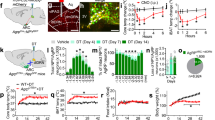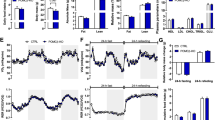Abstract
The lateral hypothalamic area is considered the classic ‘feeding centre’, regulating food intake, arousal and motivated behaviour through the actions of orexin and melanin-concentrating hormone (MCH)1,2,3. These neuropeptides are inhibited in response to feeding-related signals and are released during fasting. However, the molecular mechanisms that regulate and integrate these signals remain poorly understood. Here we show that the forkhead box transcription factor Foxa2, a downstream target of insulin signalling4,5,6, regulates the expression of orexin and MCH. During fasting, Foxa2 binds to MCH and orexin promoters and stimulates their expression. In fed and in hyperinsulinemic obese mice, insulin signalling leads to nuclear exclusion of Foxa2 and reduced expression of MCH and orexin. Constitutive activation of Foxa2 in the brain (Nes-Cre/+;Foxa2T156Aflox/flox genotype) results in increased neuronal MCH and orexin expression and increased food consumption, metabolism and insulin sensitivity. Spontaneous physical activity of these animals in the fed state is significantly increased and is similar to that in fasted mice. Conditional activation of Foxa2 through the T156A mutation expression in the brain of obese mice also resulted in improved glucose homeostasis, decreased fat and increased lean body mass. Our results demonstrate that Foxa2 can act as a metabolic sensor in neurons of the lateral hypothalamic area to integrate metabolic signals, adaptive behaviour and physiological responses.
This is a preview of subscription content, access via your institution
Access options
Subscribe to this journal
Receive 51 print issues and online access
$199.00 per year
only $3.90 per issue
Buy this article
- Purchase on Springer Link
- Instant access to full article PDF
Prices may be subject to local taxes which are calculated during checkout




Similar content being viewed by others
References
Willie, J. T., Chemelli, R. M., Sinton, C. M. & Yanagisawa, M. To eat or to sleep? Orexin in the regulation of feeding and wakefulness. Annu. Rev. Neurosci. 24, 429–458 (2001)
Shimada, M., Tritos, N. A., Lowell, B. B., Flier, J. S. & Maratos-Flier, E. Mice lacking melanin-concentrating hormone are hypophagic and lean. Nature 396, 670–674 (1998)
Sakurai, T. et al. Orexins and orexin receptors: a family of hypothalamic neuropeptides and G protein-coupled receptors that regulate feeding behavior. Cell 92, 573–585 (1998)
Wolfrum, C., Besser, D., Luca, E. & Stoffel, M. Insulin regulates the activity of forkhead transcription factor Hnf-3beta/Foxa-2 by Akt-mediated phosphorylation and nuclear/cytosolic localization. Proc. Natl Acad. Sci. USA 100, 11624–11629 (2003)
Wolfrum, C., Asilmaz, E., Luca, E., Friedman, J. M. & Stoffel, M. Foxa2 regulates lipid metabolism and ketogenesis in the liver during fasting and in diabetes. Nature 432, 1027–1032 (2004)
Matsuzaka, T. et al. Crucial role of a long-chain fatty acid elongase, Elovl6, in obesity-induced insulin resistance. Nature Med. 13, 1193–1202 (2007)
Tronche, F. et al. Disruption of the glucocorticoid receptor gene in the nervous system results in reduced anxiety. Nature Genet. 23, 99–103 (1999)
Bernardis, L. L. & Bellinger, L. L. The lateral hypothalamic area revisited: neuroanatomy, body weight regulation, neuroendocrinology and metabolism. Neurosci. Biobehav. Rev. 17, 141–193 (1993)
Hara, J. et al. Genetic ablation of orexin neurons in mice results in narcolepsy, hypophagia, and obesity. Neuron 30, 345–354 (2001)
Gomori, A. et al. Chronic intracerebro-ventricular infusion of MCH causes obesity in mice. Melanin-concentrating hormone. Am. J. Physiol. Endocrinol. Metab. 284, E583–E588 (2003)
Ludwig, D. S. et al. Melanin-concentrating hormone overexpression in transgenic mice leads to obesity and insulin resistance. J. Clin. Invest. 107, 379–386 (2001)
Alon, T. & Friedman, J. M. Late-onset leanness in mice with targeted ablation of melanin concentrating hormone neurons. J. Neurosci. 26, 389–397 (2006)
Hagan, J. J. et al. Orexin A activates locus coeruleus cell firing and increases arousal in the rat. Proc. Natl Acad. Sci. USA 96, 10911–10916 (1999)
Hara, J. et al. Genetic ablation of orexin neurons in mice results in narcolepsy, hypophagia, and obesity. Neuron 30, 345–354 (2001)
Byberg, L., Zethelius, B., McKeigue, P. M. & Lithell, H. O. Changes in physical activity are associated with changes in metabolic cardiovascular risk factors. Diabetologia 44, 2134–2139 (2001)
Aadahl, M., Kjaer, M. & Jorgensen, T. Associations between overall physical activity level and cardiovascular risk factors in an adult population. Eur. J. Epidemiol. 22, 369–378 (2007)
Assah, F. K., Brage, S., Ekelund, U. & Wareham, N. J. The association of intensity and overall level of physical activity energy expenditure with a marker of insulin resistance. Diabetologia 51, 1399–1407 (2008)
Stolk, R. P. et al. Insulin and cognitive function in an elderly population. The Rotterdam study. Diabetes Care 20, 792–795 (1997)
Young, S. E., Mainous, A. G. & Carnemolla, M. Hyperinsulinemia and cognitive decline in a middle-aged cohort. Diabetes Care 29, 2688–2693 (2006)
Komulainen, P. et al. Metabolic syndrome and cognitive function: a population-based follow-up study in elderly women. Dement. Geriatr. Cogn. Disord. 23, 29–34 (2007)
Baranowska, B., Wolińska-Witort, E., Martyńska, L., Chmielowska, M. & Baranowska-Bik, A. Plasma orexinA, orexin B leptin neuropeptide Y (NPY) and insulin in obese women. Neuroendocrinol. Lett. 26, 293–296 (2005)
Nagy, A., Rossant, J., Nagy, R., Abramow-Newerly, W. & Roder, J. C. Derivation of completely cell culture-derived mice from early-passage embryonic stem cells. Proc. Natl Acad. Sci. USA 90, 8424–8428 (1993)
Franklin, K. B. J. & Paxinos, G. The Mouse Brain in Stereotaxic Coordinates 3rd edn (Elsevier, 2007)
Acknowledgements
This study was supported by grants from SystemsX and the Swiss National Science Foundation (LiverX grant). We would like to thank S. Metref for technical support and expertise.
Author Contributions J.P.S.: project design, characterization of mice, transcriptional activation, preparation of manuscript; F.v.M.: immunohistochemistry, nuclear/cytosolic immunoblot analysis, characterization of mice; J.H.: nuclear/cytosolic immunoblot analysis; B.T.: hypothalamic adenovirus injections; C.W.: generation and characterization of mice; M.S.: project design, preparation of manuscript.
Author information
Authors and Affiliations
Corresponding author
Supplementary information
Supplementary Figures
This file contains Supplementary Figures 1- 7 with Legends. (PDF 5424 kb)
Rights and permissions
About this article
Cite this article
Silva, J., von Meyenn, F., Howell, J. et al. Regulation of adaptive behaviour during fasting by hypothalamic Foxa2 . Nature 462, 646–650 (2009). https://doi.org/10.1038/nature08589
Received:
Accepted:
Issue Date:
DOI: https://doi.org/10.1038/nature08589
This article is cited by
-
Construction of a High-Density Genetic Linkage Map and QTL Mapping for Growth-Related Traits in Takifugu bimaculatus
Marine Biotechnology (2020)
-
Vagal Blocking for Obesity Control: a Possible Mechanism-Of-Action
Obesity Surgery (2017)
-
Foxa1 is essential for development and functional integrity of the subthalamic nucleus
Scientific Reports (2016)
-
Divergent and convergent roles for insulin-like peptides in the worm, fly and mammalian nervous systems
Invertebrate Neuroscience (2014)
-
Nato3 Integrates with the Shh-Foxa2 Transcriptional Network Regulating the Differentiation of Midbrain Dopaminergic Neurons
Journal of Molecular Neuroscience (2013)
Comments
By submitting a comment you agree to abide by our Terms and Community Guidelines. If you find something abusive or that does not comply with our terms or guidelines please flag it as inappropriate.



